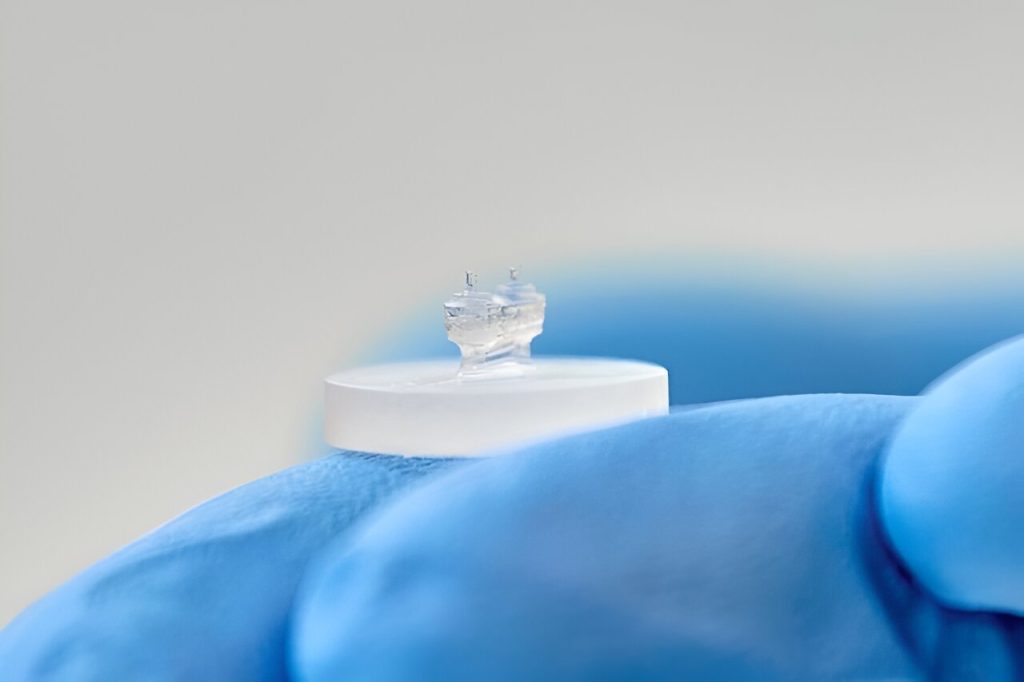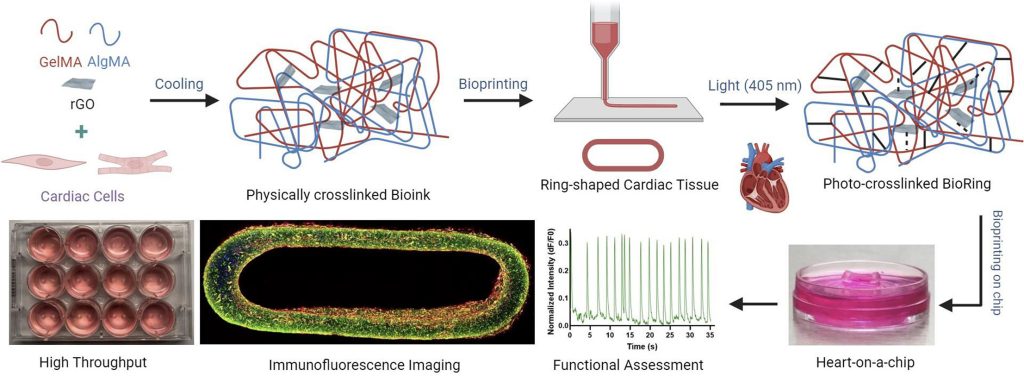Researchers from Centre de recherche Azrieli du CHU Sainte-Justine, a think tank affiliated with the Université de Montreal (UdeM), have developed a new bioink optimized for 3D printing “heart on a chip” devices.
The new 3D printable composite bioink is said to accurately reflect the electrical activity, mechanical properties, and physiology of a human heart.
The research team used this material to 3D bioprint ring-shaped “heart on a chip” cardiac devices with a range of different cardiac cell types. A high-throughput, automated 3D bioprinting process was used to fabricate the heart model in 12-well plates.
The new 3D printed cardiac models could be used to help medical professionals gain a greater understanding of individual cases of heart disease, and in the development of new cardiac-related drugs.
In the future, the team hopes to 3D print heart models from the cells of cardiac patients, allowing for personalized medical treatment for specific heart disease cases.
The research team, led by UdeM pharmacology professor Houman Savoji and doctoral student Ali Mousavi, has published its findings in the latest edition of Applied Materials Today.
“Our research has made it possible to combine 3D bioprinting technology to produce standard hearts-on-a-chip much more quickly and precisely,” commented Savoji in a Medical Xpress article. “What’s more, our results show that printed devices perform better than those produced manually.”

3D printed “heart on a chip”
The new 3D printable bioink is based on photocrosslinkable natural polymers gelatine methacryloyl (GelMA) and alginate methacrylate (AlgMA), as well as electroconductive reduced graphene oxide (rGO) nanomaterials.
According to the study authors, this is the first time that AlgMA has been used for a tissue cardiac engineering application.
Throughout their research, the scientists synthesized and characterized the hydrogel components, formulating the bioinks with a range of material concentrations. To develop the optimal 3D printing bioink formulation, the team investigated the physicochemical, structural, electromechanical, cytotoxicity, 3D printability, and degradation properties of the different combinations.
Different cell types were also incorporated when 3D printing the cardiac devices. These included neonatal rat cardiomyocytes, cardiac fibroblasts, and HL-1 cells.
The team’s optimized bioink formulation is said to support a high level of cardiac cell viability, proliferation, spreading, elongation, and alignment. This enables the “heart of a chip” devices to accurately reflect real human heart function, including cellular spontaneous beating.
“We’ve formulated a bioink that best reproduces the properties of the heart, such as elasticity and electrical conductivity, and has suitable properties required for 3D bioprinting,” stated Mousavi, the study’s first author.
Currently, most “heart on a chip” devices are produced individually in laboratories in non-standardized methods. As such, they often lack scalability to industrial-scale production. Within this research project, the team utilized an automated, high-throughput 3D bioprinting process which saw the heart models produced in 12-well plates. It is hoped that this approach could increase the adoption of 3D printed cardiac devices in the medical sector.
Looking to the future, the researchers will further develop their 3D printed “heart on a chip” for drug identification and testing applications. Combining the new bioink with patient stem cells will allow patient-specific heart models to be 3D printed, facilitating the development of personalized heart medication.
“The next step will be to compare healthy and diseased heart cells to develop solid cardiac pathology models. That will also let us safely and accurately test the effect of new therapeutic molecules on cells,” added Mousavi.

3D printing advances medical sector
In a recent survey on the 3D printing trends to watch out for in 2024, 3D printing experts pointed to the growing adoption of additive manufacturing within healthcare. In particular, 3D printing is being increasingly leveraged to produce personalized medical devices and tools at the point of care.
The Montreal-based research team is not the first to develop a 3D printed “heart on a chip” device. Last year, five Belgian companies and research centres collaborated as part of the AstroCardia project to 3D print an artificial heart and circulatory system. The research patterns include Space Application Services, SCK CEN, QbD Group, BIO INX and Antleron.
This 3D printed heart will be sent to the International Space Station (ISS) in 2025, where the heart’s aging process will be studied as the organ ages 20 times faster in space than on earth.
Away from cardiac research, scientists from University of Wisconsin-Madison (UW-Madison) recently developed a novel approach to 3D printing functional brain tissue. The team’s horizontal 3D printing process can create active neural networks inside and between the brain tissue.
The researchers believe that the 3D printed brain tissue can provide an effective tool for modeling the neural network under physiological and pathological conditions, and can also serve as an effective drug testing platform.
Subscribe to the 3D Printing Industry newsletter to keep up to date with the latest 3D printing news. You can also follow us on Twitter, like our Facebook page, and subscribe to the 3D Printing Industry Youtube channel to access more exclusive content.
Are you interested in working in the additive manufacturing industry? Visit 3D Printing Jobs to view a selection of available roles and kickstart your career.
Featured image shows the ring-shaped 3D printed “heart on a chip”. Photo via Véronique Lavoie, CHU Sainte-Justine.


